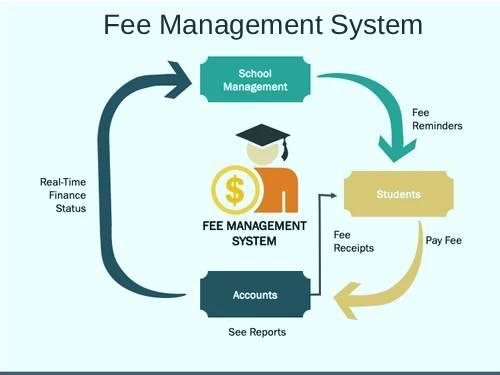Top Fee Management System Trends Transforming Education in 2025
Education is changing rapidly in today’s digital-first world. One of the most important areas seeing innovation is fee management systems. For decades, fee collection and financial administration in schools and colleges were done manually—leading to errors, inefficiencies, and unnecessary stress for both administrators and parents. But now, technology is transforming the way institutions handle payments, automate tasks, and deliver smoother financial experiences.

As we move deeper into 2025, Fee Management Systems are no longer just about collecting fees—they have evolved into comprehensive financial ecosystems. From AI-powered automation to mobile-first solutions and sustainable payment practices, these systems are shaping the future of education finance. Let’s explore the biggest trends institutions should watch.
1. Artificial Intelligence and Automation Take Center Stage
Artificial Intelligence (AI) has become a backbone of the modern fee management system. By automating repetitive tasks, institutions save valuable staff hours and reduce the risk of human error.
-
Automated invoicing and reminders: Schools no longer need to manually draft fee slips or chase late payments—AI handles it instantly.
-
Smart analytics: By analyzing historical payment data, AI predicts trends, helping administrators adjust fee structures more effectively.
-
Fraud detection: Advanced algorithms monitor unusual payment activities, providing an additional layer of financial security.
-
Personalized communication: AI tailors reminders and alerts based on student preferences, improving timely responses.
In short, automation is shifting staff time from administration to student support and strategic growth.
2. Mobile-First Fee Solutions
Today’s parents and students expect convenience. The rise of smartphones has made mobile-first fee management systems an essential feature for schools and universities.
-
Students and parents can pay anytime, anywhere, without visiting offices.
-
Push notifications remind users of deadlines, reducing late payments.
-
User-friendly app designs ensure smooth navigation, even for first-time users.
As institutions increasingly cater to tech-savvy generations, mobile-first solutions are becoming standard practice.
3. Seamless Integration with Other Systems
Fee management doesn’t exist in isolation. Institutions now demand systems that integrate seamlessly with Student Information Systems (SIS), Learning Management Systems (LMS), and Customer Relationship Management (CRM) tools.
Benefits include:
-
Centralized data management: Avoid duplication and maintain updated student records across departments.
-
Comprehensive reporting: Compare academic performance with financial health for better decision-making.
-
Single sign-on for students: One login works across multiple platforms, improving the user experience.
This trend reflects a larger push in education: creating unified digital ecosystems where finance, academics, and communication all flow together.
4. User Experience Becomes a Priority
Gone are the days of clunky dashboards. In 2025, User Experience (UX) is one of the most important success factors for any fee management system.
-
Simple, intuitive designs help even non-technical users process payments quickly.
-
Gamification features, such as reward points for timely payments, improve engagement.
-
Continuous feedback loops allow institutions to refine systems in real time.
With smoother experiences, schools not only improve compliance but also strengthen relationships with parents and students.
5. Stronger Security and Compliance
Financial data is highly sensitive. As cyber threats rise, institutions are prioritizing security-first fee management systems.
Key developments include:
-
Multi-factor authentication (MFA): Adding extra layers of protection before transactions.
-
Advanced data encryption: Ensuring every transaction remains confidential.
-
Regular audits: Detecting vulnerabilities and ensuring compliance with data protection laws.
Trust is essential in financial dealings. By strengthening security, institutions protect both their reputation and their community.
6. Flexible and Diverse Payment Options
In 2025, one-size-fits-all payments no longer work. Modern fee management systems are embracing flexibility to suit different financial needs.
-
Installment plans: Students can spread fees into manageable amounts.
-
Digital wallets: Parents can pay via PayPal, Google Pay, or Apple Pay.
-
Cryptocurrency adoption: Though still in early stages, some universities are experimenting with Bitcoin and other digital currencies.
This flexibility helps institutions maintain steady cash flow while making education more accessible to families.
7. Sustainability and Green Practices
Sustainability is influencing nearly every industry, and education is no exception. Modern fee management systems are now designed with eco-friendly practices in mind.
-
Paperless transactions eliminate the need for printed receipts and invoices.
-
Green incentives encourage digital payments and environmentally conscious choices.
-
Sustainability reporting helps institutions demonstrate accountability to stakeholders.
Aligning fee management with sustainability goals not only reduces costs but also builds a stronger brand image among environmentally aware students and parents.
Conclusion: The Future of Fee Management Systems
The future of fee management systems is not just about collecting payments—it’s about building trust, ensuring security, and creating seamless experiences for students, parents, and administrators alike.
From AI automation to mobile-first designs, integrated platforms, security protocols, and sustainability initiatives, the education sector is witnessing a major shift in how financial processes are managed.
For institutions, adopting these trends means reducing administrative burdens, improving cash flow, and focusing on what matters most: delivering quality education.
In 2025 and beyond, the institutions that embrace modern fee management systems will not only streamline their financial operations but also strengthen relationships with their communities.







